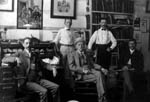
Katherine Alexander
Born in 1897 in Fort Smith, her mother, Sophronia, was part Cherokee. Her father, Josiah Alexander, farmed land nearby in the Indian Territory while living with his family on this side of the river. Katherine Alexander's father died when she was almost six years of age.
Shortly thereafter, her mother moved the family to Baltimore where her mother, "a frustrated musician," saw that Katherine received a formal musical education and learned to play the violin. Later, she and her mother moved to New York to further her training. As a girl and later when between engagements as an actress, she would return to Fort Smith to visit family and babysit her nieces and nephews, always maintaining her voter and car registration in Sebastian County. In her late teens, Katherine Alexander was cast in a play which required an actress who could play the violin. Around this time, she told her mother that she was giving up music to pursue acting full-time. Her musical abilities became her way into a profession that she enjoyed more than music and that she ultimately worked in for more than 30 years. After winning a few more parts on Broadway, she joined Jessie Bonstelle's stock company in Rhode Island. Mrs. Bonstelle was an accomplished acting coach and it was under her direction that Katherine Alexander was able to further hone her innate acting skills.
In the theaters on Broadway and elsewhere, she worked almost constantly, playing lead parts and supporting roles in a variety of plays. According to her niece, Gordon Kelley, "She never had a big hit and she never had a bad review. Not a single one. The critics all just loved her." Among Katherine Alexander's own favorite performances were her title role in That Awful Mrs. Eaton, about Andrew Jackson's scandal-plagued White House hostess and as an Irish immigrant boy in Little Old New York.
In 1925, she married Broadway producer William A. Brady Jr. with whom she had one daughter, Barbara. Despite having a family, she neither abandoned them nor her career. She and Brady made their home in New Jersey where they kept horses and dogs. Katherine Alexander made a two-hour trip by train to the theaters on Broadway, returning immediately afterward to be with her daughter and husband. Although she enjoyed socializing, counting among her friends and contemporaries, Helen Hayes and Humphrey Bogart, she was more oriented toward family than high society.
By 1933, as for many during the Depression, money had become harder to earn for her family. (This need became all the more acute when her husband died in 1935.) When she won a then-lucrative contract with Metro-Goldwyn Mayer studio for $15,000 a year. Katherine took Barbara and her mother to Hollywood. Typecast by MGM as a comedienne and forced to compete with Rosalind Russell for many of the same parts, she nevertheless was a success as an actress in supporting roles in such films as Death Takes A Holiday with Frederic March, The Barretts of Wimpole Street with Charles Laughton, Anna Karenina, Now, Voyager with Bette Davis, and The Human Comedy among many others. When she was able to get out of her MGM contract after a few years, Katherine Alexander was able to win a greater variety of roles and intersperse her schedule of film work with stage work.
Gordon Kelley said, "They had her do so much comedy and we always thought that tragedy was where she would be the best." In 1949, she got her chance in one of the most famous of all modern tragic plays as Linda in the London theater debut of Death of a Salesman, playing opposite Paul Muni. So compelling was her performance, one of her fans attended nearly every show, sitting in the front row. Holding a bouquet of flowers, the man would lean forward looking into Katherine Alexander's face during one part of the play in which she had to kneel at the edge of stage and deliver a soliloquy.
Kelley remembered, "She was terrified for fear that he was some kind of nut, but he was just theater-struck."
Apart from one final play in summer stock in 1951, her part in Death of a Salesman was her last one. Instead of retiring in southern California or New York, Katherine Alexander chose to return to her family in Fort Smith and the city that she always called home. She settled into a house on Rogers Avenue that she had inherited from her mother. For the next 26 years, she made her home there, staying busy with her family, with activities at St. John's Episcopal Church that she attended and with gardening. She died in 1977 while caring for an older sister in North Carolina.
When asked whether her aunt ever had any regrets about not having had a more traditional life or career, Kelley said, "She wasn't the kind of person who had regrets, very, very courageous always. She felt that she had a very interesting life."
Old Fort Museum newsletter, 1994.

Katherine Alexander, 1935.
